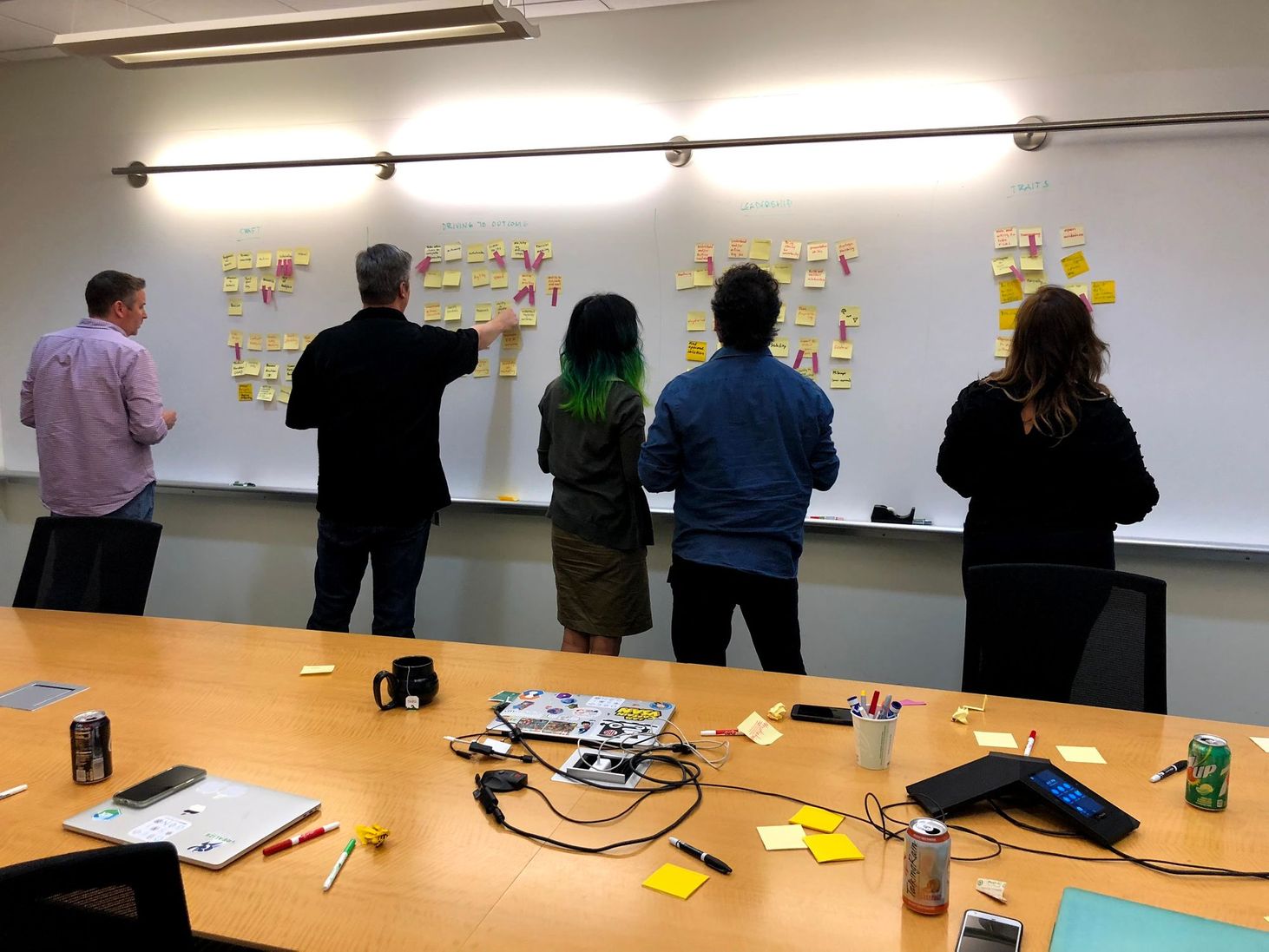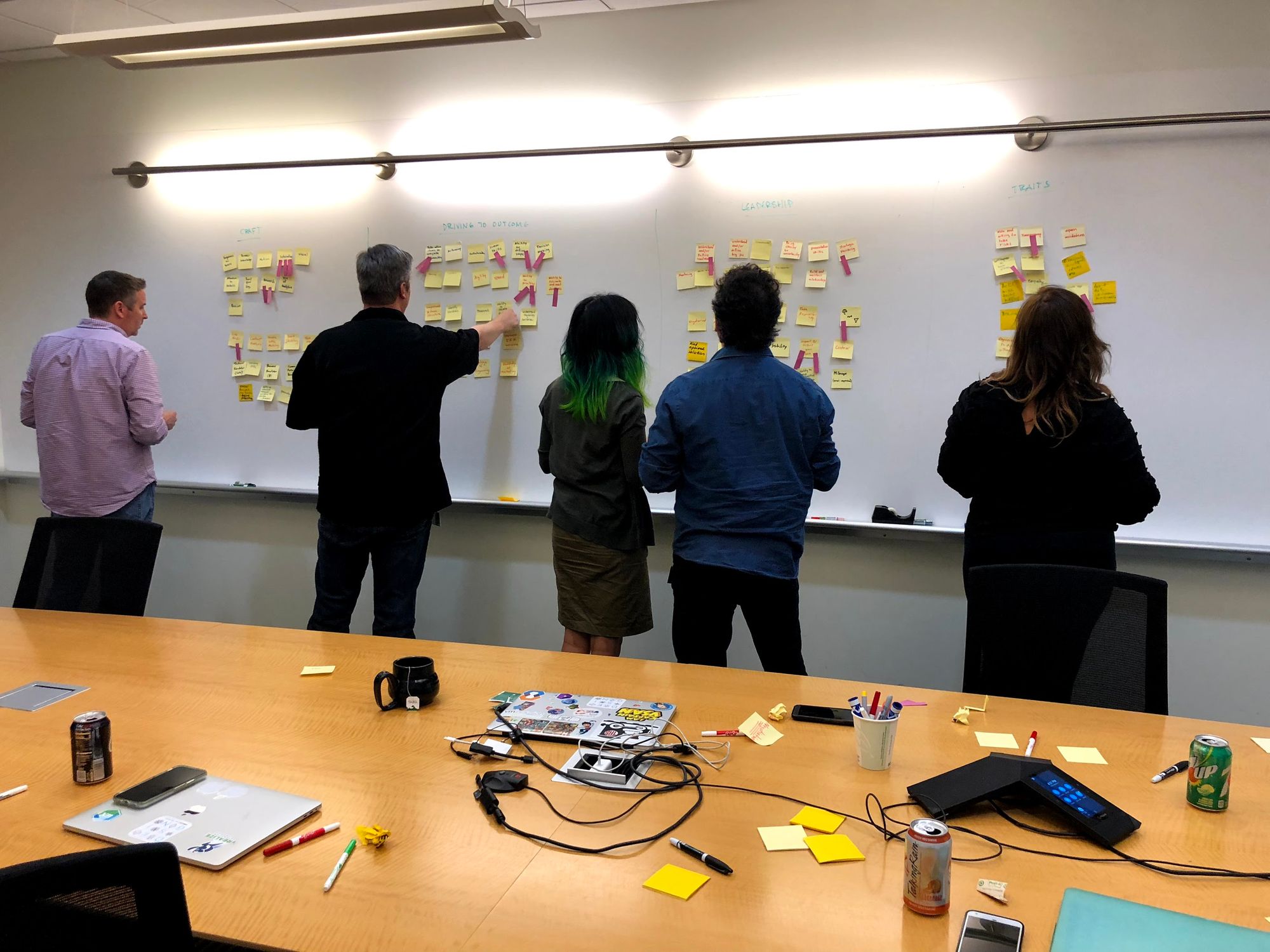Building your team's skills matrix

A couple of years ago, we began a movement to transform design at VMware and with it, transform VMware itself into an experience-led company. Anybody who’s been a part of a transformation would tell you that the most important part of a transformation is people. How you transform the culture and the designers themselves is the most important change you can make as a leader. They can then help you transform design itself at the company.
As part of that transformation, we found it important to get on the same page about the skills we found essential and the new skills we wanted the team to have as we grow.
Although the effort to come up with a design matrix was started by me, the process was a collaborative one that included all product designers and product design managers. Every single designer in every single location participated in this.
What is a skills matrix?
A skills matrix is a well-articulated set of core skills a team identifies as essential to succeed. They include skills in the design craft itself and other skills required to produce excellent work, collaborate and communicate effectively, and the skills needed to lead. Although every single individual might not, every team, collectively, should have these skills to be successful.
Start with the principles
Setting up clear principles before starting the process was an essential step to ensure all product design teams that went through the process were able to work from a clear starting point. Having a clear direction of the expected outcome allowed us to have far more productive and effective conversations than we would’ve otherwise.
A skills matrix, if done right, should allow a team to align on the skills this team needs to have, overall. This means that teams and not individuals, should have a mix of all of these skills to be successful. It should outline the mix of skills we currently have, skills we know we really need, and skills industry teams have that we need to get better at. Some of those skills might not be applicable to your current team but it is extremely important to not fall into the trap of building a matrix that represents your current team versus the team you want to transform into. The skills matrix should also ensure that all of the above is articulated well as to allow teams to identify with a level of certainty what skills they have and which ones they don’t.
The core framework

In addition to clear principles, we needed a clear framework that allows us to orient our thinking. The framework’s goal is to provide guidance on the direction we needed while providing enough canvas for the team to draw within. A framework was also needed so we focus on a diverse set of skills. Design teams generally drift towards focusing too much on craft and too little on other areas that are core to a collaborative and functioning team.
The framework we followed was inspired by Atlassian’s. It is built around four core categories:
- Craft: this is the core set of skills for that role (differ per role. For example, craft for a researcher will be different from product designer).
- Driving for outcome: this evaluates our ability to take projects from A to Z.
- Leadership: this evaluates our leadership skills and abilities.
- Traits: focused on culture principles and cultural contribution. In this one, we look for the cultural traits in a team that we won't compromise on. For example, our ability to take risks, open mindedness, etc.
The process
One of the lessons we learned as we went through the process is that the process of coming with the matrix itself was as important as the resulting outcome.
We started by dividing the team into groups of 8 people. Each group had different members of different design teams, different seniority levels, and different locations to ensure we’re hearing a diverse set of voices and perspectives. The diversity of issues these designers are facing and the skills they have allowed these workshops to be more open minded and well-rounded.

We scheduled each workshop for two full hours. As we went through the agenda, we made sure it covers the steps we needed to have a productive workshops that allowed us to get clear results.
Core principles, expected outcomes, and logistics
The first fifteen minutes were spent on providing an overview of the exercise itself. We shared the goals, principles, and framework. Then, we allowed for a few of minutes of questions on the process itself. I also explained in these fifteen minutes that I am here as a listener. Once the workshop starts, the team is responsible for organizing themselves. They can continue to ask me questions about the process itself.
Spend the time to think of skills in each framework category
The next thirty minutes were designated to designers to write down a set of skills in every one of the four main framework categories. Designers spent this time on their own but put these skills up on the whiteboard.
Vote for the skills you’d like to see highlighted in each framework category
The following thirty minutes were spent on designers voting on each one of the skills they thought were important to have in a diverse and effective team. They got 4 - 5 votes per framework category. This was also a chance for designers to explain, to each other, the skills they put together on the board and to group skills that are either the same or extremely similar.
The team works together to determine the top 10 across the board
The last 45 minutes was the best and most interesting part of the exercise. Designers were asked to agree together on the top 10 skills for a team to have across the board in all framework categories. Every single designer had the right to veto the decision. This meant designers needed to work together to convince each other of the top 10 skills across the board.
Generally, teams were able to organize themselves clearly. Leaders organically emerged to facilitate and the first four or five skills in the top ten were easy to agree upon. Interaction design, research, and more were clear and early winners.
It got very interesting from there. Designers started sharing what they believed were top ten skills and sharing the stories and experiences of why they believed they’re important.
I learned in these sessions, by listening to designers, more than I learned in the weeks before as I talked to the team. The context of these workshops allowed designers to freely share their experiences in the context of the skills we needed as a team.
Different teams also thought of different ways to convince each other of skills. Almost all teams decided to try and vote for more than ten then go back and eliminate a few.
As teams started eliminating choices, almost all of them were unable to go down to the limit of 10. As teams did this, I simply allowed them to keep all the 12 or 13 they highlighted. The goal wasn’t to get to 10 anyway, it was to get to the minimum set of top skills needed.
As we looked through all workshops that we’ve conducted throughout the three weeks we did this, a theme and a pattern started emerging. Although we didn’t end up with just ten, we actually did end up with a core set of skills per category and clear set of top 12 skills that we needed in teams across all categories.
After the workshops
After all workshops ended, the management team got together to understand and compile the results. Having the management team attend every single workshops proved essential. We discussed, in details, the results we’ve seen from different workshops in context of the discussions we heard in the room. At the end, we built a single skills matrix that combined the efforts of these teams in the workshops with the readings of the management team.
The team building their own skills matrix was a powerful way for them to transform their own team into the future.
Integrating the skills matrix into people development, hiring, and more
Building a skills matrix is one thing, using it is yet another exercise.
Today, we use the skills matrix in three main areas:
- Career development and growth: as we build our career development and career ladder details, the skills matrix is at the core of what we work together to evaluate.
- Hiring: as we grow our team significantly this year, the skills matrix is how we understand the skills our design teams have and the skills we lack. It’s how we decide resourcing, evaluate candidates, and what we work with new hires on.
- Training: when we discuss training and conference opportunities, we use the skills matrix to focus on areas where the team needs to move forward and ensure that we’re covering some of it in our training both at conference and internally.
Next steps
Although the skills matrix has been a huge benefit to the team, there is a lot more to be done. This is especially true around how we use it in the context of career development and growth.
One especially important area that we need to build on is how we continue to develop and update the matrix itself. Since doing this, our team has more than doubled. This means we now need to go through the set of skills matrix workshops again. Developing a way to do this on annual basis allows us to stay ahead of the curve and continue to educate new designers joining the team on why, not just the end result of the skills matrix.
If you've done this before in your team or have feedback. I'd love to hear from you.
My Name Is Jehad Newsletter
Join the newsletter to receive the latest updates in your inbox.

